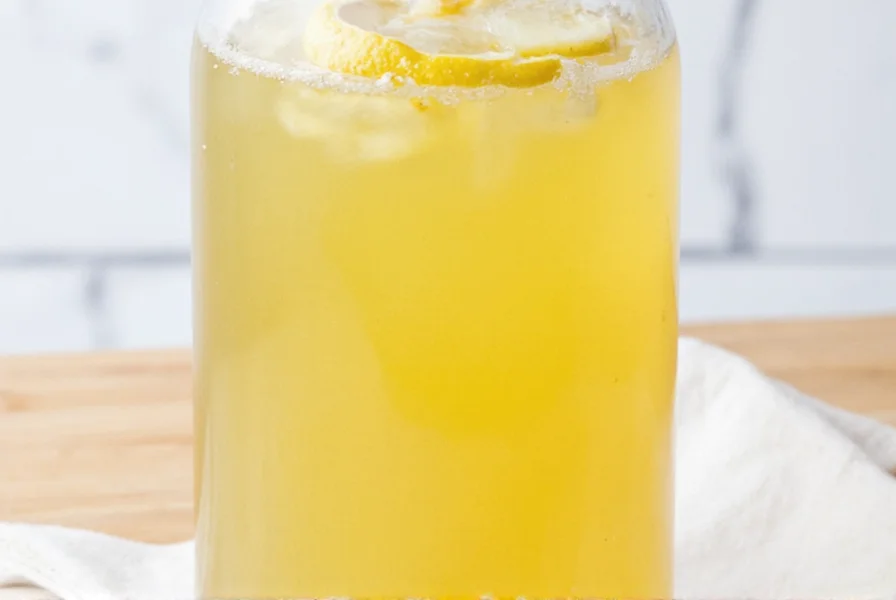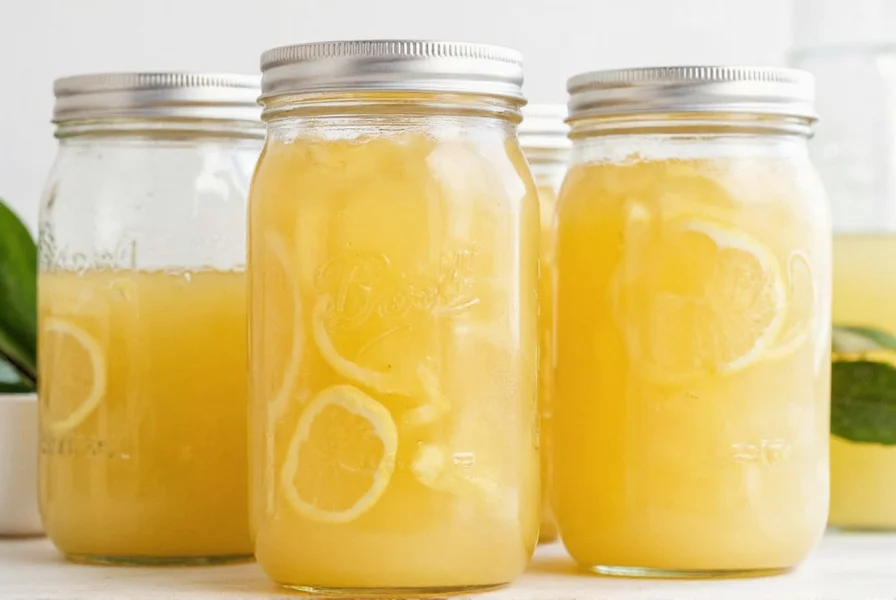Homemade lemon ginger ferment offers a refreshing, probiotic beverage that supports digestive health while delivering the anti-inflammatory benefits of ginger and vitamin C from lemons. Unlike store-bought versions that often contain preservatives, this natural fermentation process creates billions of beneficial bacteria through wild fermentation—no starter culture required. The resulting drink, sometimes called "ginger bug" or "lemon ginger kefir," provides a customizable base for mocktails or a straight probiotic tonic.
Essential Ingredients and Equipment
Creating a successful lemon ginger ferment starts with quality ingredients and proper equipment. Each component plays a specific role in the fermentation process:
| Ingredient | Amount | Function |
|---|---|---|
| Organic lemons (washed) | 2 medium | Provide natural yeast, acidity, and vitamin C |
| Fresh ginger root | 2 inches | Contains wild microbes and adds flavor complexity |
| Organic cane sugar | 2 tablespoons | Feeds beneficial bacteria during fermentation |
| Filtered water | 4 cups | Chlorine-free medium for fermentation |
For equipment, you'll need a 1-quart glass mason jar, a breathable cover (cheesecloth or coffee filter secured with rubber band), and a non-metal stirring utensil. Avoid metal containers as they can react with the acidic ferment. A plastic or wooden spoon works best for stirring.
Step-by-Step Fermentation Process
Follow these precise steps for a successful lemon ginger ferment recipe that yields a consistently delicious probiotic beverage:
- Prepare ingredients: Thoroughly wash lemons (organic is essential as you'll use the peel). Grate 1 tablespoon of lemon zest from one lemon. Slice both lemons thinly, removing any seeds.
- Combine components: Place lemon slices, zest, grated ginger, and sugar in your clean glass jar. Add 1 cup of filtered water and stir until sugar dissolves.
- Add remaining water: Fill the jar with additional filtered water, leaving 1-2 inches of headspace for expansion during fermentation.
- Cover and store: Secure breathable cover over the jar and place in a dark location at room temperature (68-75°F or 20-24°C).
- Stir daily: Gently stir the mixture once daily with a non-metal utensil to distribute microbes and prevent mold.
- Monitor fermentation: After 3 days, taste daily until it reaches your preferred tartness (typically 5-7 days).
- Strain and bottle: Remove solids and transfer liquid to airtight bottles for secondary fermentation (optional for carbonation).
Understanding the Fermentation Science
The magic of this lemon ginger ferment recipe happens through wild fermentation, where naturally occurring yeasts and bacteria on the lemon peel and ginger consume sugars and produce beneficial compounds. During the 3-7 day process:
- Natural yeasts convert sugars to carbon dioxide and alcohol
- Lactic acid bacteria transform remaining sugars into lactic acid
- The pH gradually drops from around 6.0 to 3.0-3.5, creating preservation
- Probiotic bacteria populations reach 1-10 billion CFU per serving
This traditional fermentation method creates a more diverse microbial profile than commercial starters, potentially offering broader health benefits. The process self-preserves as acidity increases, eliminating the need for refrigeration during primary fermentation.
Troubleshooting Common Fermentation Issues
Even with careful preparation, your lemon ginger ferment might encounter challenges. Here's how to address common issues:
- White film on surface: This harmless kahm yeast appears as a thin white layer. Simply skim it off and continue fermentation.
- No bubbles forming: Ensure your environment stays above 65°F (18°C). Add 1 teaspoon of organic raisins to introduce additional wild yeast.
- Excessive mold: Discard the batch if you see fuzzy, colored mold. Prevent future issues by ensuring clean equipment and proper headspace.
- Overly sour taste: Shorten fermentation time in future batches. The ideal window is typically 5-7 days at room temperature.
- Weak carbonation: For fizzier results, add 1 teaspoon sugar before bottling and allow 1-3 days for secondary fermentation.
Customizing Your Fermented Beverage
Once you've mastered the basic lemon ginger ferment recipe, experiment with these variations:
- Herbal infusions: Add mint, basil, or rosemary during the last 24 hours of fermentation
- Fruit enhancements: Include slices of apple, berries, or pineapple for additional flavor complexity
- Spice variations: Incorporate cinnamon sticks, cloves, or turmeric for different health benefits
- Sweetness adjustments: Reduce sugar to 1 tablespoon for a less sweet, more probiotic-dense ferment
- Alcohol content: Extend primary fermentation to 10-14 days for a naturally low-alcohol beverage

Health Benefits and Consumption Guidelines
Regular consumption of homemade lemon ginger ferment provides several evidence-based health benefits. The probiotic content supports gut microbiome diversity, which research links to improved digestion, immune function, and even mood regulation. Ginger contributes anti-inflammatory compounds like gingerols, while lemon provides vitamin C and flavonoids.
For optimal benefits, consume 2-4 ounces daily, preferably before meals to aid digestion. Start with 1 ounce if new to fermented foods to allow your system to adjust. Store finished ferment in the refrigerator where it will keep for 2-3 months, though flavor will continue to develop and intensify over time.
While generally safe for most people, those with histamine intolerance or compromised immune systems should consult a healthcare provider before consuming homemade ferments. Unlike commercial probiotic products with standardized strains, wild ferments contain variable microbial populations.
Frequently Asked Questions
How long does lemon ginger ferment last in the refrigerator?
Properly stored in an airtight container, homemade lemon ginger ferment maintains quality for 2-3 months in the refrigerator. The flavor will continue developing, becoming more vinegary over time. Always check for signs of spoilage like mold or off odors before consuming.
Can I use bottled lemon juice instead of fresh lemons?
No, bottled lemon juice won't work for this wild fermentation process. It lacks the natural yeasts present on lemon peels that initiate fermentation and contains preservatives that inhibit microbial growth. Always use organic, unwaxed lemons that you can safely use with the peel.
Why does my lemon ginger ferment taste too sweet after 7 days?
If your ferment remains overly sweet after 7 days, the temperature may be too low for optimal microbial activity. Move the jar to a warmer location (70-75°F/21-24°C). You can also add 1 teaspoon of organic raisins which carry additional wild yeast to boost fermentation activity.
Is it normal for my lemon ginger ferment to smell alcoholic?
Yes, a mild alcoholic aroma during fermentation is normal and indicates active yeast converting sugars. The final product typically contains less than 0.5% alcohol by volume, similar to many kombuchas. If the smell becomes strongly alcoholic (like wine), fermentation has progressed further than intended—refrigerate immediately to slow the process.











 浙公网安备
33010002000092号
浙公网安备
33010002000092号 浙B2-20120091-4
浙B2-20120091-4